Two broke friends in San Francisco decided to raise money by renting their living room. They put in three air mattresses and advertised this to attendees of the design conference. Knowing that all hotels were fully booked, they knew they had a shot.
And that’s it!
The next day, they bought the domain airbedandbreakfast.com and six days later they had three guests sleeping in their living room for $80 a night.
That’s how their MVP was born.
Instead of prolonging the release of their idea by doing extensive research or beautifying their site, they launched its raw version quickly. As they started getting good responses from their customers, they grew it with time and added new features to it. From 2007 to 2020, airbedandbreakfast.com has not just changed into Airbnb, it has also added several new features to it and catered to a larger audience across the globe.
This is what an MVP does to your product idea.
It gives you a minimal product initially to test on your early adopters. Once you know it will be loved, you can go on adding new features as per the feedback received.
But it's not as easy as it seems. and that's where this guide will come to help.
It will help you know more about Minimum Viable Product and MVP development. Alongside, you will also get to know the complete cost of building your MVP and the ways to succeed with it.
Let's get started.
Chapter 1
What Is An MVP?
Most of the successful startups and product companies have made it big with a minimum viable product.
Not sure what it is?
This chapter explains MVP in the simplest way to help you get started.
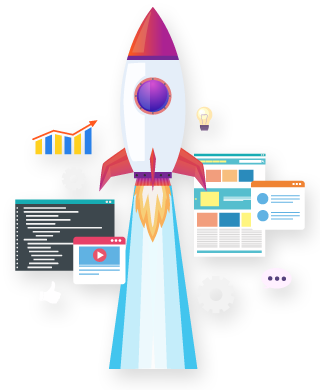
Think of humans. Were we the same thousands of years ago in the stone age as we are today?
No!
We started out from being simple chimpanzees that evolved into homo erectus, then homo antecessors, and finally into homo sapiens sapiens. At each stage, we learned something and evolved into a better and more functional version of ourselves. Someone who could survive in the situation and win over the challenges thrown by life.
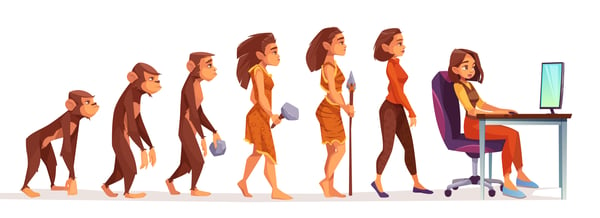
This can be perfectly resonated with MVP development process. The first-ever version of humans was enough to survive during the stone age and thus became the first MVP. But as per the environmental needs, we evolved and became better.
An MVP is the minimum viable product that you can offer your customers to get validation and move ahead with building the final product. It is important that you start with an MVP first in order to get market validation for your idea. In fact, an MVP can supercharge your digital product and help you scale it.
Starting with an MVP is starting smart- you have market validation, you avoid the risk of failure, and you save on your business costs.
Starting with MVP development means you follow the ‘build-measure-learn’ loop.
You join hands with MVP development companies to build a product’s MVP quickly to solve a real-world problem. It gives you market acceptance, tells you the usefulness of the product, and gives its financial implications in a clearer manner. Once you have a practical solution and have tested the feasibility of your product or app idea, getting ahead with the final product development can offer better results.
Now you Know
- Having an MVP means delighting your users with the minimum product with the most basic features.
- It follows the build-measure-learn loop for product development.
- You build a prototype, test is with early adopters to get market validation, and scale as per their feedback.
Chapter 2
Why MVP?
Still confused if you should start with an MVP or launch the full product?
This chapter tells you why Uber, Airbnb, and other big product companies launched their MVP first.
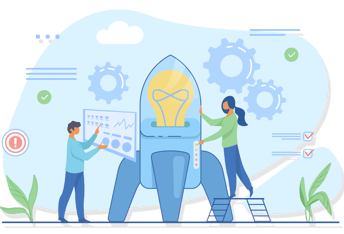
The main reason you need a minimum viable product is to get your startup product idea out there without actually exploiting your complete product funds. There are many successful products that were an MVP first. Uber, Airbnb, and Spotify to name a few.
They didn’t go all-in with building their startup product. Rather, they started small and worked in small steps to build their final product. Let’s find out why.
1. Test Market Demands
Before launching any product, it is important to know if the product would work in the market or not. It’s about testing the market demand for that MVP idea to ensure its success. You need to know that the need for your product exists in your targeted market but cannot invest your entire amount in that. Therefore, an MVP can help you test the same and continue with the idea, improvise it, or completely pivot based on the findings by measuring the MVP performance.
2. Delight Early Adopters
Each product has some early adopters on whom the beta version of a product is tested. Your MVP could be that beta version. Your early adopter will need a product idea that is stripped down to the bare minimum. No fluff, no add-on features- just a basic functioning product. You can create a working MVP and delight them with it. They will become your brand loyal advocates forever. There are many reasons why startups need MVP development and delighting the early adopters is just one of them.
3. Launch Working Product Faster
There is an unending race that every startup or product company is running. The race to deliver something faster than their contemporaries. With an MVP, you can actually reach out to your target audience faster. An MVP doesn’t take that much time to build and you can quickly offer something to them before your competitors so that they associate with your product more. Launching faster enables you to test it early-on and get their feedback earlier.
4. Market Validation
Same as testing market demand, getting market validation is important before you launch your product. Every business assumes that its product would work well during the market research stage. But it is important you verify your assumptions and an MVP helps you achieve that.
5. Mitigate Risks
There are many risks associated with product development. You cannot invest all your funds on mere assumptions- it is super risky. Going with an MVP development, you can invest a small share of your entire product funding and know if the product idea would work. It helps you mitigate the risks and avoid any big failure.
6. Testing Business Model
If you are a startup and your product is your main business model, it is very important that you get validation for the model. An MVP allows you to ensure that your business model is in sync with the market demand. Moreover, the faster development of MVP would mean that you can analyze your process beforehand and make improvements accordingly.
7. Defining Monetization Strategy
You wouldn’t want to launch a product without a monetization strategy on how to get returns from your investment. For example, if you are planning to launch a mobile app, you can know whether one monetization strategy (say, in-app purchases ) would work. If it doesn’t work with the MVP, you can look for new strategies to monetize effectively.
Now you Know
Starting with an MVP is the preferred move by most startups and product companies. Here's why:
- It helps test market demands and delight early adopters
- It helps launch the product faster and get market validation on the product idea
- It helps mitigate a number of risks and test the business model
- It helps define & pivot monetization strategy
Chapter 3
MVP Development Roadmap
Want to go ahead with MVP development but don't know where to start?
Here is a step-by-step guide to help you develop your minimum viable product.

While you know that you need an MVP before launching your final product, there is a question that might arise in everyone’s mind. How do you start with it? There are some steps that you need to take when you are planning for MVP development. Even if you are joining hands with an MVP development company, it is imperative that you know each step of the development process.
In this section, we have explained in very simple terms the step-by-step process of planning an MVP development.
Step 1: Market Research/Product Discovery
One of the biggest reasons behind failed startups is that their product has no market need. Almost 42% of the startups failed because of this very reason!
The first step to building a minimum viable product is to perform in-depth market research. Not only do you need to analyze your target audience, but you also need to know if there is any competition out there.
- What Problem Would The Product Solve?
Look for the problem that you intend to solve with the product. Identify a gap in the market that your product can fill in. This would tell you a lot about the problem that you intend to solve with your future product and its MVP.
- What Is Your Ideal User Persona?
No matter what business you are in, having a buyer persona is imperative. And same is the case with MVP development as well. You need to know the future customers of your product to get more insights. - Is There a Market Need?
Conduct surveys on your target audience to know if they actually have a need for your product idea. Ask them questions about the problem and if they need a solution for the same or are they satisfied with what’s available to them right now.
- What Is Your Competitor Doing?
Do in-depth research on your competitors and what makes their product stand-out. See if they have any particular strategy that is making them more successful.
- What Makes Your Product Stand Out?
If there are already products that solve the problems that you intend your product to solve, it is important that you know what makes your product stand out. This will help you in the next steps of your MVP development where you have to prioritize the features.
Step 2: Define User Flow
The next step in planning your MVP development is the defining and user flow or user journey. How they will use your product and in what stages. Look at your product from your users’ perspective and map their journey. In order to define the user flow journey, you need to start with stages through which the users would flow.
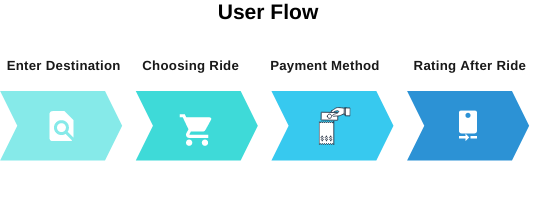 If we take the example of a ride-sharing app like Uber, its stages would be entering the destination, choosing the type of ride, applying coupon code (if they have one), choosing the payment method, and making the payment once the ride has ended.
If we take the example of a ride-sharing app like Uber, its stages would be entering the destination, choosing the type of ride, applying coupon code (if they have one), choosing the payment method, and making the payment once the ride has ended.
Depending on your product idea or business model, you need to get in your users’ shoes and see what all steps they would like to take. Also, you need to find out the ending or the last action they might want to take, the goal of the product.
Once you have defined your user flow, you can move to the next step.
Step 3: Prioritizing Product Features
The third and one of the most important steps in planning your MVP development is listing all the features and prioritizing them. For each stage or step of the user flow defined in the last step, start creating a list of the features that would work. By the end, you will have a list of several features that you will need in your product.
But right now, we are talking about your minimum viable product. So, you need to start prioritizing. There are two things you need to ask-
- What features are absolutely necessary for the core actions?
- What features can you mark as add-ons?
Once you have answered both these questions, it’s time you start categorizing your features in ‘must-have’ and ‘not-necessary’. They should be sorted based on priority as well- high priority, medium priority, and low priority. You can also jot them down in the following manner.
.png?width=536&name=MVP%20development%20guide%20(1).png)
Another way to prioritize the features of your MVP is to know what impact the features would have on your MVP and what the urgency is.
For example, if you are creating an e-commerce site- adding a payment option is a must-have. So, the urgency for this is very high and it needs to be included in the MVP. Then, there would be features that might look super urgent but not have that high impact on the working of the MVP. You can check the feature out and see if it can be included in this version or can be reserved for the next version launch.
A chart like the following can be very helpful in categorizing the features in the manner discussed above.
.png?width=536&name=MVP%20development%20guide%20(13).png)
Step 4: MVP Development
Now that you have a list of the important features for your MVP, let’s move on to the important part- MVP development. The most convenient, time-saving, and cost-efficient way of building your minimum viable product is to join hands with an MVP development company. They can deliver a much better result with their professional experience and expertise.
During the entire MVP development stage, keep one thing in mind- your MVP shouldn’t be any less than your product. It should be able to fulfill what your early adopters seek. At the same time, delight them to keep them coming back.
Also Read: Useful Tips To Develop A Successful MVP
Here, we also need to throw some light on the different approaches that you can take to build your MVP. Here is a gist of the same.
-
No-Product MVP: The approach where you do not get any actual building block of your product rather just a visualization of your idea.
-
Product-Mockup: This is the usual MVP approach where you launch a product without any sophisticated technology and only later does it use complex technologies like Machine Learning, blockchain, etc.
-
Single-Feature MVP: This is the type of minimum viable product where you only launch an MVP with just one feature.
-
MLP: This is the minimum lovable product that is built to delight the target audience with improved user experience.
-
EVP: EVP is the Exceptional Viable Product that is very close to the final version of your product to gain more recognition quickly.
-
Prototype: This is just a model of your product sans any features which acts as a base for your MVP.
Once you know the type of start you want to give to your product or MVP, you can approach a trusted MVP development company or set up a team of MVP developers to build the product prototype.
Step 5: Track Feedback & Measure
No work is complete until you measure the performance. And measuring the performance of the prototype holds extreme prominence in MVP development. Once your MVP is built, you need to take it to the next level and turn it into a minimum marketable product. And once it is launched among your early adopters, you need to be very careful in taking their feedback and analyzing how they are working on the same.
The example of Nike changing its CTA is one of the best examples of why you need to constantly monitor the feedback of your customers. Not all the customers were able to identify the ‘buy now’ button when it only had the price mentioned on it. Thus, they changed it to ‘Buy’ with the price to make things clearer.
.png?width=536&name=MVP%20development%20guide%20(12).png)
It is important that you review each and everything that your client says about your initial product (MVP). But just collecting feedback is not enough.
You also need to track their behavior and the success of the MVP to know if you can work on rolling out its next versions or need to implement your business model.
Now you Know
- Every MVP development process starts with market research & product discovery
- The next step is defining the user flow
- Setting priorities for product features
- After that, you need to get the MVP developed by a team of expert developers
- Tracking feedback & analyze them
Chapter 4
Measuring MVP Success
You need to carefully monitor and measure its success to scale as desired.
In this chapter, you can find the factors you can use to measure your MVP success.

There are several things that you need to take into consideration when you are measuring the success of your MVP. An in-depth analysis of your product success can tell you the future scope of your product and how it would turn out in the coming times. Here are some of the most effective ways that you can follow to measure your MVP success. Let’s get reading.
1. Feedback
The first thing that anyone needs to check out when they have launched their MVP is the feedback. You need to collect customer feedback from both the Alpha testers (your family & friends) as well as the Beta testers (the early adopters). You can interview your customers about the product that you have launched and list out all the problems they had or what they expect to see further.
2. Engagement
The engagement rate of your product is another important factor to measure its success in the market. You can check the session time as well as the clicks they make, the time they spend, etc., to know what’s engaging them or what’s driving them away.
3. Net Promoter Score
There are various survey-based metrics that help you can check to know the overall success of your MVP and the net promoter score is an important metric. You can use various feedback apps and ask questions around recommending it to others or rating their experience. It captures their feedback on a scale of 0 to 10 and gives you a score. This score can tell you how well the users liked your MVP and if they would recommend it or not.
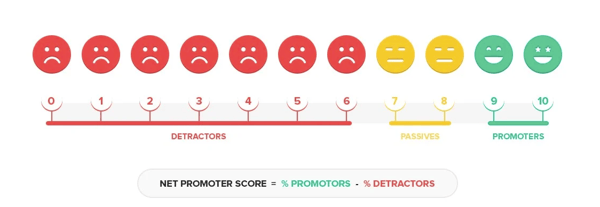
4. Active Users
You can know the success of your MVP by checking the daily monthly users (DAU) and monthly active users (MAU). Check if your average active user metric is going up or down. This can tell you if your MVP is engaging the users or simply turning them away.
5. Average Revenue Per User
This is the average revenue that any product company can expect to generate from a single user or customer. By knowing this metric, you can be sure to understand if the product is generating products or creating a loss.
6. Sign-Ups
This is yet another factor you can check to measure the success of your MVP is the number of sign-ups it can offer. The more sign-ups, the better your minimum viable product is performing among the users.
7. Customer Acquisition Cost
This is the amount you spend on acquiring a single customer. You can calculate it by using the formula- money spent on lead generation / number of customers. This will tell you exactly how much you are spending on acquiring a single customer. If the revenue generated per user is lesser than the customer acquisition cost, the MVP is not profitable and you need to implement your revenue strategy or traction channels. But if it is vice versa, you can sit back and enjoy it.
8. Churn Rate
Last but not the least, you also need to check the churn rate of your MVP. This is the rate at which the customers uninstalled your product or stopped using it. This can tell you a lot about the success of your MVP.
Now you Know
Measuring your MVP success is a crucial step. Here are the metrics to check:
- Customer Feedback and the Net Promoter Score
- Engagement that the early adopters have with your MVP
- The number of Active Users for your product prototype
- The average revenue and the customer acquisition cost for each user
- The number of new sign-ups to your MVP along with the churn rate
Chapter 5
Cost Of Building MVP
You've chosen to build an MVP first but don't know how much it would cost?
Worry not!
In this chapter, we have explained the complete cost of building an MVP.

The biggest reason why most startups or even product agencies start with an MVP first is that it saves a lot of costs. You can build an MVP at a much lower cost compared to product development. But the question is- How much does MVP development cost?
The cost of outsourcing a product has been talked many times but not many have talked about the cost of MVP development. So, in this section, we will break up the cost of building an MVP.
For that, we need to throw light on all the factors that determine the MVP cost.
Hiring MVP Developers/Teams/Company
The first cost that emerges when you plan to build an MVP is the cost of the builders; i.e., the MVP developers, MVP development team, or an MVP development company. You can choose from any of the three options depending on the resources you can invest and the complexity of your MVP. But keep in mind, each of the approaches has its own costs attached to it.
.png?width=536&name=MVP%20development%20guide%20(14).png)
-
If you are hiring a remote developer to build a good MVP, the cost could be around $15,000-$20,000 on an average for their MVP development services.
-
If you plan to outsource MVP development to India or any other popular outsourcing region, you can rest assured to get a great MVP with the best version in the first go. The price might range anywhere between $30,000 and $50,000. However, this would include everything from ideation and research to building and launch.
-
You can also set up a team of MVP developers, designers, testers, and others to build your MVP development. Outsourcing product development while starting with MVP with the same company can be beneficial and cost-effective in the long run.
Designing Cost
The next cost that comes to the fore when you are building a minimum viable product is the designing part. The MVP needs to be minimum viable or a bare skeleton of the actual product. But it still needs to delight the early adopters. The UI and UX have to be simple yet intuitive and engaging.
Also Read: Simple Ways To Improve Performance And UX
It includes the planning & preparation, wireframe development, and the creation of a mockup of the MVP. All the things included and the time required for each of the steps, this might cost around $500 or more for wireframing and around $500-$1,000 for the mockup. The more complex your MVP becomes, the more interactions it would need in the design and the price would increase accordingly. Adding more screens to your MVP would also increase the cost as it would need designing for each screen individually.
.png?width=536&name=MVP%20development%20guide%20(11).png)
Features & Complexity Of MVP
The next and the most important factor that determines the cost of MVP development is the complexity. Generally, an MVP is supposed to be the most basic version of any product. However, the more complex your product is, the more features you’ll need in the first version itself.
As discussed earlier, prioritizing the features can be done using various ways and you need to keep the cost in mind as well during prioritization. You can talk to the MVP development company or the remote MVP developers to include only the must-have features and one or two nice-to-have features in the first version.
Make sure the features do not escalate your development time as the more time the developer needs to build the features, the higher would your MVP development cost be. Moreover, the more screens you want for your MVP, the price would increase according to that as well.
Technology Used For MVP
Another factor that determines the overall cost of building your minimum viable product is the technology stack that would be used for the same. If you join hands with an MVP development company, they help you with the technology selection as well. However, if you are hiring remote teams or a single developer for your MVP or even choosing to develop it on your own, you’ll need some recommendation from an expert for your technology selection.
Choosing the best tech stack for powering your MVP is an important step. You can choose from MEAN/MERN stack, PHP, Laravel, Meteor, Django, Python, Ruby on Rails, or any other technology based on the features and the complexity of your product. You can find developers of each technology stack at varying prices.
Time Taken
Time is of utmost importance and one of the main factors why people choose to go for a minimum viable product initially. The faster your MVP is developed. The more profitable it would be. A company working with more developers and completing the development in a shorter time should be preferred compared to a company taking a long time. Why?
The answer is simple. The faster you are able to launch your MVP, the faster you will be able to test it with your early adopter and get a better ROI.
You can get feedback from your early adopters quickly and implement changes to release the next updated version. Moreover, faster release of the MVP would mean that your idea would not be stolen and the competition would still be less while you roll it out.
Calculating the Cost
All in all, the cost of building an MVP depends largely on the factors we have discussed above. You can have a ballpark estimate of the MVP by taking the hours for development and the cost of developers into consideration. If you choose an MVP development company, they can give you an estimate of the development costs more precisely.
If you have a product like Uber, the vision of your product would majorly determine its cost. However, an estimation of the same would tell us that the cost might come around $45,000-$115,000 if you choose a product development company for outsourcing MVP development. The platform of the app also determines the cost.
This is because Uber requires a number of panels and features even if you start with an MVP. You need to have the main passenger page to book a cab, passenger profile page, admin panel, driver panel, payment page, ratings at the end, geolocation feature, and many more.
If your product is not as complicated, the MVP development cost can be much less.
Now you Know
One of the most important things to do is know the actual cost. Here are the factors that determine the cost:
- MVP designing cost
- Hiring MVP developer, team, or company
- Features or complexity of your MVP
- Time taken in development
Chapter 6
Successful MVP Examples
There are several startups that have succeeded through a Minimum Viable Product.
Read on to find the MVP approach adopted by startup unicorns.

A quick Google search on “examples of MVP” and you will come across hundreds of posts listing the most successful MVPs. This is enough to prove that MVP development has made many businesses into a success story and role model. So, let’s get started with reading some good examples of MVP development.
Spotify
The music streaming platform also started out as an MVP in the beginning. Spotify AB was the first prototype for this platform that was up and running in just four months. The beta version was then launched in 2007.
“We spent an insane amount of time focusing on latency when no one cared because we were hell-bent on making it feel like you had all the world’s music on your hard drive. Obsessing over small details can sometimes make all the difference. That’s what I believe is the biggest misunderstanding about the minimum viable product concept. That is the V in the MVP.” – Daniel Ek, founder of Spotify.
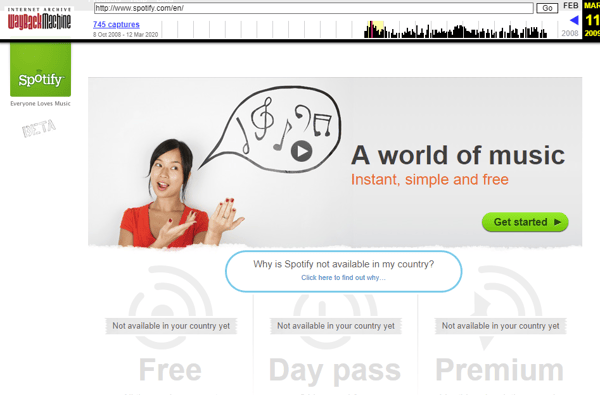
Soon, it expanded to all parts of the world and new features were added to this existing app. There is a freemium version, playlist creation, song sharing, and whatnot available to the song listeners on Spotify.
Uber
The cab-hailing app Uber is one of the most successful ventures and is today among the top-grossing apps across the world. Two friends in Paris were unable to hail a cab on a chilly winter night. This gave them the idea of having a timeshare limo ordering on an app. After buying the UberCab domain in 2009, they started making a prototype.
Only three cars were on the first prototype in 2010 that allowed them to book a cab in just one tap of the button. It was a very simple product- booking a cab, track movement via GPS, and make payment using a card.
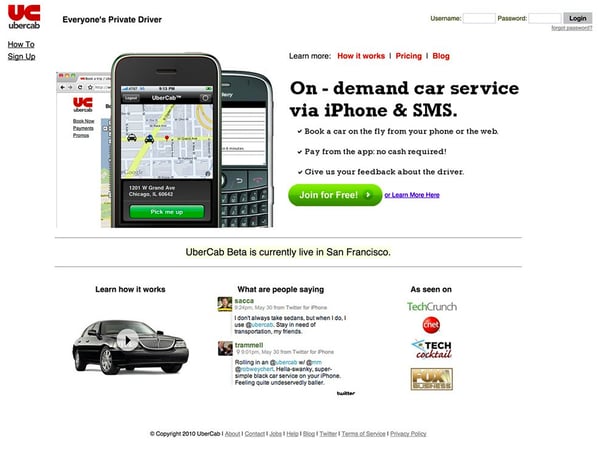
Based on the user feedback, the cab-hailing service added new features to the app and new functionalities were added. Now, there are many new features that are far from the initial MVP. You can have driver live tracking, fare splitting, ride-sharing, fare estimation, mobile wallet linking, etc.
Airbnb
Brian Chesky and Joe Gebbia, two roommates short on their room rent in San Francisco, came up with the idea of putting a mattress in their living room and offering it as bed & breakfast. They launched airbreadandbreakast.com in 2008 as a single web page.
Compared to the present Airbnb application, this website didn’t have that many features. It could only provide feasible renting spaces in your desired location.
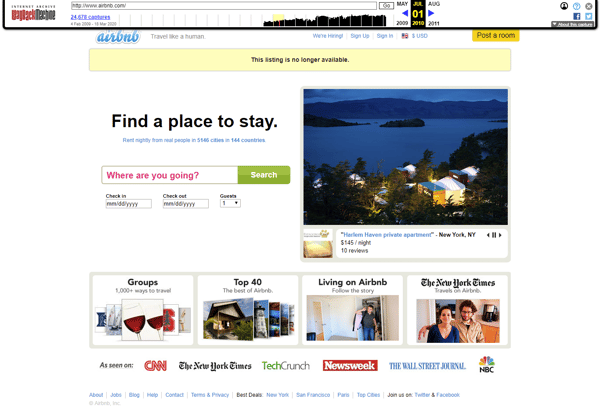
Over the years, it took feedback from the users and improved its experience. Today, we can see options like monthly stays, experiences, online experiences, and much more to cater to the needs of people.
Amazon
Jeff Bezos read a report in the 1990s that web commerce was going to experience a boom of 2,300%. That’s when he created a list of 20 products that could be marketed online and prioritized five from them. Narrowing it down further, he chose books from the five products and decided to sell them online.
The first amazon website had a catalog of books where a user could order a book and Amazon would buy it from the distributor and ship it to the buyer. Gradually, it expanded the horizon and made sure people could find everything there.
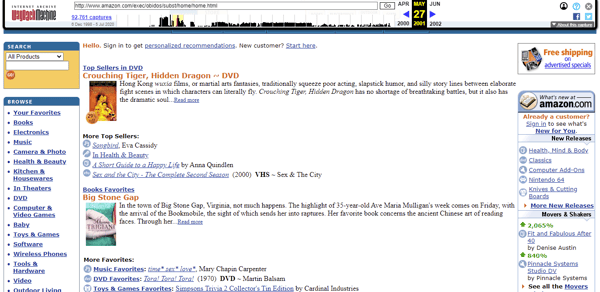
Today, Amazon is one of the largest e-retailers worldwide and sells almost anything one can imagine.
Zappos
Nick Swinmurn, the founder of Zappos, wanted to sell shoes online but had no inventory or funds for the same. So, he created an online portal ShoeSite.com where he posted pictures of shoes he personally took from the store. If someone purchased the product from there, he would himself go to the store, purchase it, and deliver it to the address. This MVP model worked great.
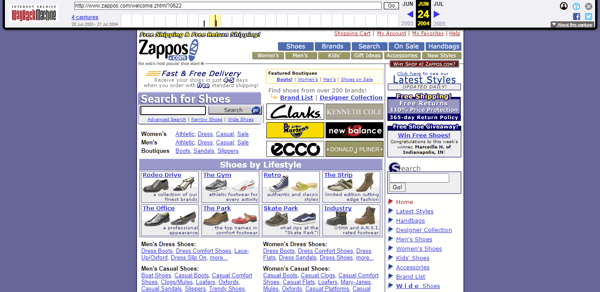
Today, it not only sells shoes but clothing, handbags, accessories, and much more. It believes in delivering WOW to its customers at each step.
Today, with over 1.69 million users worldwide, Facebook is one of the biggest social media platforms connecting people. Their MVP or minimum viable product was simply about connecting students based on their classes and colleges. This went viral with people and people loved the connecting app.
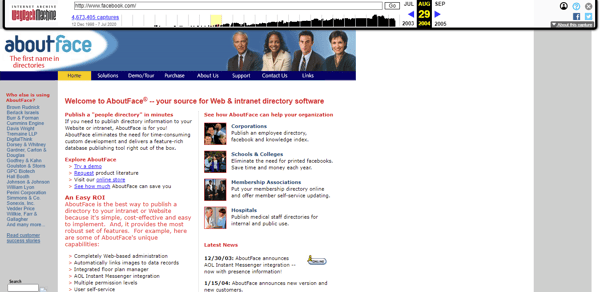
It was Thefacebook back then and didn’t have all the features and functionalities that it has today. Only a small group of early adopters tested the application and gave feedback on it. Today, there are so many functionalities added to the application.
Twitter is today one of the most trending social media platforms where one can share mini content posts to their followers. The invention of hashtag (#) is linked to this platform only. It was started with a very simple idea- sharing a message of 140 characters with a small group of people. It was a prototype used by people of Odeo (where the four founders worked) to send messages to people among the employees.
Soon, there was a spike in the number of tweets from 20,000 per day to 60,000 tweets. There were many new features added to the platform and now it has over 284 monthly active users.
Now you Know
- There are so many examples of startups that became industry leaders by starting with a minimum viable product.
- Amazon, Facebook, Spotify, Airbnb, Twitter, Zappos, and Uber are some of the most successful examples of products that started with an MVP first.
Conclusion
There have been so many stories sung in the praise of MVP development that it is hard not to get excited about it. Undoubtedly, starting with an MVP is the way to go, especially for all entrepreneurs and product companies. The benefits that it can have are unending- from giving you a kickstart to helping you improve with the user feedback.
But the majority of the people have always had some confusion about MVP development and choosing the right MVP development company for their business success. We hope to have cleared most of your doubts through this simple guide. Just stay simple and remember- your MVP need not be the best version; it needs to be the minimum version that is able to delight the users.
To conclude, we would only like to say a simple thing- if you have the right MVP development partner by your side, you’re already on your way to success. And you can save even more costs by outsourcing MVP development to a trusted firm.
If you have a product idea in mind, we can be the MVP development company to turn it into a successful product. We have assisted many startups and product companies in developing a successful product- starting with an MVP. Our MVP development approach is simple that allows you to scale your MVP to success. You can outsource MVP development to us or hire developers and a full MVP development team as your project demands.


























